In the tapestry of the natural world, few creatures possess a feature as distinct as the strange legs of ostriches.
Towering and seemingly out of proportion, these legs are an evolutionary marvel that has evolved to serve a unique set of purposes.
Ostriches, the largest and fastest-running birds on Earth, boast legs that have become an emblem of their adaptation to specific ecological niches and survival strategies.
The question of why do ostriches have strange legs beckons us to explore the intricate relationship between form and function in the realm of biology.
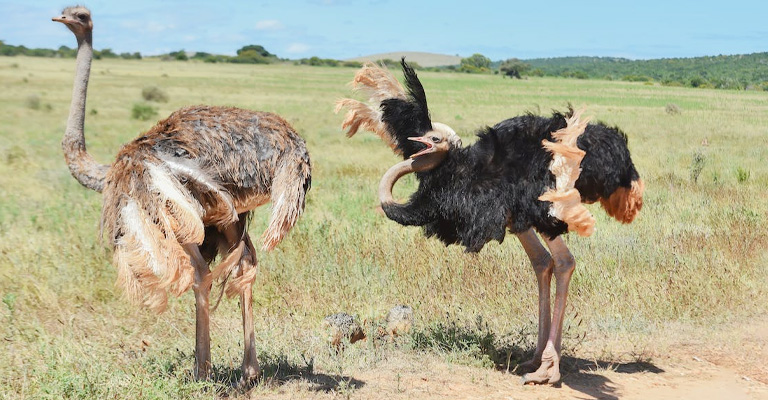
Why Do Ostriches Have Strange Legs?
Ostriches are fascinating birds that have some unique features that make their legs seem strange to us.
Here are the reasons why ostriches have strange legs:
Longest And Heaviest Legs
Ostriches have strong, powerful legs that can propel them across the land at speeds of up to 43 miles per hour1.
They use their wings to balance and steer and their legs to accelerate and brake. They can also cover up to 16 feet in a single stride. Their legs are also very graceful and elegant, and they can perform impressive kicks and jumps.
Largest Tarsus
The tarsus is the lowest upright part of the leg, covered in scales. The tarsus of the common ostrich is the largest of any living bird, measuring 39 to 53 cm (15+1/2 to 21 in) in length. The tarsus helps the ostrich to run fast and efficiently, as it reduces the rotational inertia of the leg.
Two Toes On Each Foot
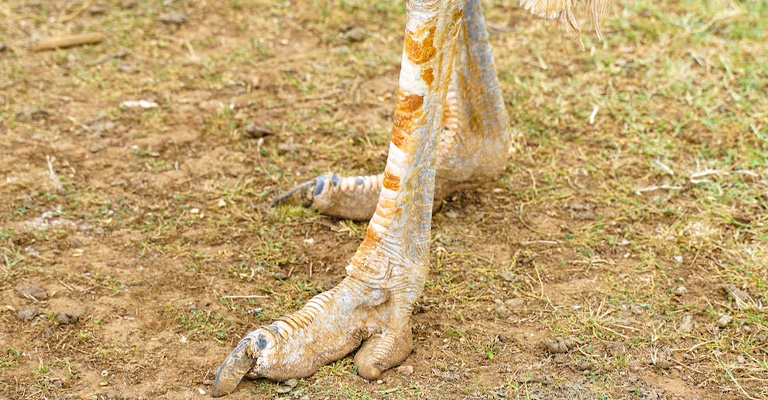
Ostriches are the only living birds that have two toes on each foot, instead of three or four.
The toes are unequal in size, with one large toe that bears most of the weight, and one smaller toe that acts as a stabilizer. The toes are also clawed, which helps the ostrich to grip the ground and defend itself.
Double Patellae
Ostriches are unique among living birds in that they have double patellae, or kneecaps, on each leg. The patellae are sesamoid bones that form within tendons, and they help to reduce friction and increase leverage for the muscles that extend the knee joint.
The function and evolution of the double patella in ostriches are still unclear, but they may be related to their high-speed running abilities.
Complex Knee Joint
Ostriches have a three-dimensional knee joint that consists of three articulations: femorotibial, femorofibular, and femoropatellar.
The knee joint is supported by various ligaments and menisci, which help to stabilize and cushion the joint. The knee joint also allows for a wide range of motion, enabling the ostrich to bend and flex its leg in different directions.
Sparsely Ossified Hypotarsus
The hypotarsus is a bony projection on the back of the tarsus, where some tendons of the leg muscles attach. In most birds, the hypotarsus is well-ossified and has several grooves for the tendons.
However, in ostriches, the hypotarsus is sparsely ossified and has only one groove for the tendon of the fibularis longus muscle. This muscle helps to rotate the foot outward and stabilize it during running.
Different Leg Colors
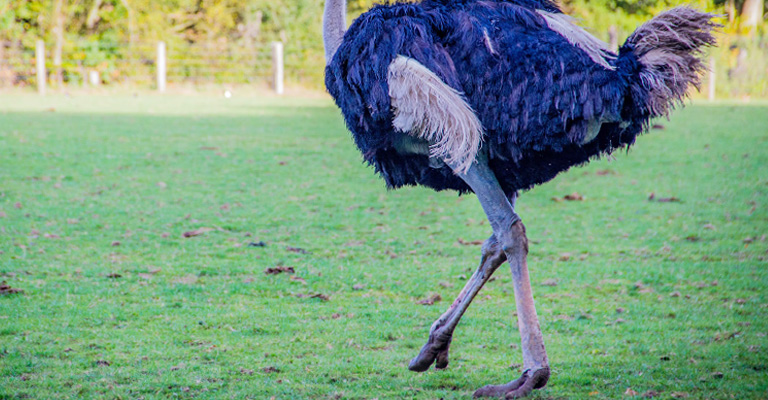
Ostriches have unfeathered legs that show bare skin. The color of the skin varies depending on the sex of the ostrich.
Male ostriches have red skin on their legs, while female ostriches have black skin on their legs. The color difference may help to distinguish males from females, as well as to attract mates during breeding season.
Different Leg Muscles
Ostriches have seven muscles that connect to their patellae, which help them to flex and extend their knee joint.
However, these muscles vary in size and shape depending on the age of the ostrich. Juvenile ostriches have smaller and more slender muscles than adult ostriches, which may reflect their different locomotor demands and abilities.
Unusual Behaviors
Ostriches have some behaviors that may seem strange or even foolish to us, involving their legs.
For example, they may sit in the rain to cool down, clean their feathers, drink water, enjoy the sensation, socialize with other ostriches, camouflage themselves, incubate their eggs, hatch their chicks, or protect their chicks.
They may also play dead when threatened by predators or peck at shiny objects out of curiosity.
These are some of the reasons why ostriches have strange legs. Of course, strangeness is subjective but we can appreciate the amazing features that help them survive and thrive in their habitats.
Why Do Ostriches Have Such Long Legs?
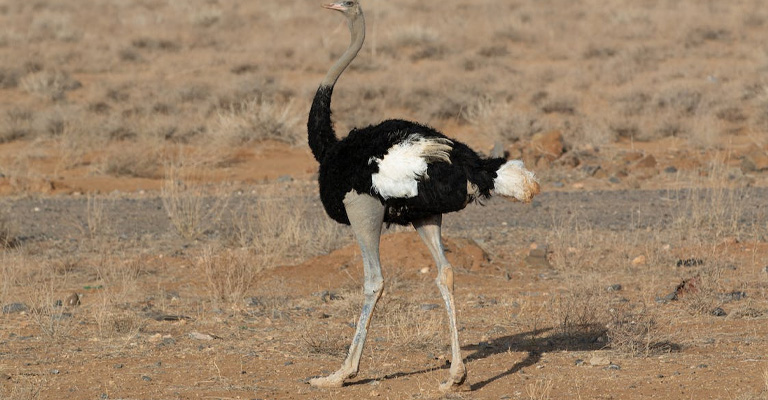
Ostriches are fascinating birds that have some unique features that make their legs very long.
Here are the reasons why ostriches have such long legs:
To Run Fast
Ostriches are the fastest land animals on two legs and can reach speeds of up to 43 miles per hour.
They use their wings to balance and steer and their legs to accelerate and brake. They can also cover up to 16 feet in a single stride. Their long legs help them to run fast and efficiently, as they reduce the rotational inertia of the leg.
To Reach High Places
Ostriches have long necks that help them reach high places and scan their surroundings for predators and prey.
Their necks are flexible and agile, and they can twist and bend them in various ways. Their long legs help them to support their long necks, and to extend their reach even further.
To Kick Hard
Ostriches have strong, powerful legs that can propel them across the land at speeds of up to 43 miles per hour.
They also use their legs as weapons and can deliver powerful kicks to fend off predators or rivals. Their long legs help them to kick hard and far, and to inflict serious damage with their clawed toes.
To Attract Mates
Ostriches have different plumage patterns depending on their sex and age. Male ostriches have black body feathers with white wing tips and tail feathers, while female ostriches have gray or brown body feathers with white spots.
Juvenile ostriches have brown or gray plumage with black stripes. Their plumage helps them camouflage with their environment, as well as display their gender and maturity.
Their long legs also help them to attract mates, as they show off their size and strength.
Male ostriches perform a courtship dance to impress the females, which involves spreading their wings, shaking their feathers, and making booming sounds. Their long legs help them to perform this dance with rhythm and grace.
Adapt To Different Environments
Ostriches are highly nomadic and will travel long distances to find suitable food and water.
They have adapted to various habitats across Africa, ranging from open arid and semi-arid regions such as deserts, savannas, and grasslands, to more vegetated areas such as woodlands and scrublands.
Ostriches prefer habitats that have enough space for them to run, forage, and nest, as well as access to water sources.
Their long legs help them to adapt to different environments, as they enable them to traverse different terrains, cope with different temperatures, and access different resources.
These are some of the reasons why ostriches have such long legs.
Why Do Ostriches Have Red Legs?
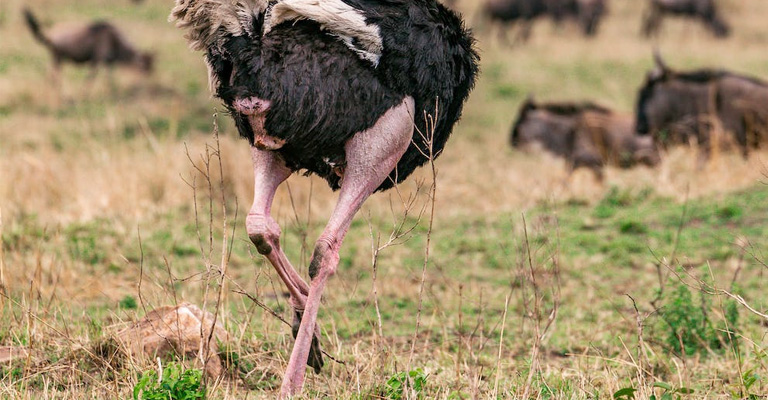
Ostriches are fascinating birds that have some unique features that make their legs very long and red.
Here are the reasons why ostriches have red legs:
To Regulate Their Body Temperature
Ostriches live in hot and dry habitats, such as deserts, savannas, and grasslands. They have a unique system of blood vessels in their skin that helps them regulate their body temperature.
They can tolerate temperatures of up to 120 degrees Fahrenheit without sweating or panting. Their red legs help them to cool down, as they increase the blood flow to the surface of the skin and dissipate heat through evaporation.
To Attract Mates
Ostriches have different plumage patterns depending on their sex and age. Male ostriches have black body feathers with white wing tips and tail feathers, while female ostriches have gray or brown body feathers with white spots.
Juvenile ostriches have brown or gray plumage with black stripes. Their plumage helps them camouflage with their environment, as well as display their gender and maturity. Their red legs also help them to attract mates, as they show off their size and strength.
Male ostriches perform a courtship dance to impress the females, which involves spreading their wings, shaking their feathers, and making booming sounds. Their red legs help them to perform this dance with rhythm and grace.
To Defend Themselves
Ostriches have strong, powerful legs that can propel them across the land at speeds of up to 43 miles per hour. They also use their legs as weapons and can deliver powerful kicks to fend off predators or rivals.
Their red legs help them to kick hard and far and to inflict serious damage with their clawed toes. Their red legs also help them to intimidate their enemies, as they signal their aggression and readiness to fight.
To Blend In With Their Surroundings
Ostriches are highly nomadic and will travel long distances to find suitable food and water.
They have adapted to various habitats across Africa, ranging from open arid and semi-arid regions such as deserts, savannas, and grasslands to more vegetated areas such as woodlands and scrublands.
Ostriches prefer habitats that have enough space for them to run, forage, and nest, as well as access to water sources.
Their red legs help them to blend in with their surroundings, as they match well with the reddish-brown soil and vegetation of some of their habitats.
To Show Their Health And Vitality
Ostriches are among the longest-living birds in the world, along with parrots and albatrosses. They are capable of living long lives of some 45 years in the wild, but some reportedly live for longer than 50 years.
In captivity, the very oldest ostriches have lived for over 60 years. The oldest was allegedly 62 years and 7 months old.
Their red legs help them to show their health and vitality, as they indicate good blood circulation and oxygen supply to their tissues. Healthy ostriches have brighter red legs than sick or old ones.
These are some of the reasons why ostriches have red legs.
FAQ
Ostriches’ unique legs are an adaptation to their lifestyle. They are well-suited for their fast-running behavior and have evolved to provide balance and agility while also aiding in energy-efficient movement across various terrains.
Ostriches’ long legs provide leverage, allowing them to take long strides. Their two-toed feet help distribute weight and provide stability.
These features, combined with strong muscles, enable them to reach impressive speeds while running.
Yes, their legs are versatile tools. Ostriches use them for defense by delivering powerful kicks.
Additionally, their height provides an advantage for scanning the surroundings for predators or food sources in the open grasslands they inhabit.
Ostriches’ legs are a result of adaptation to their habitat. The open landscapes and need to escape predators have favored the evolution of legs designed for swift and efficient locomotion, helping them survive in challenging environments.
While their legs are well-suited to their lifestyle, they can be a disadvantage when it comes to nesting.
Ostriches lay their eggs on the ground, and their long legs might inadvertently break the eggs if not careful. However, their reproductive strategy has evolved to address this challenge.
Conclusion
The enigma of ostriches’ strange legs unravels an extraordinary tale of adaptation and functionality.
These legs, seemingly odd in their design, are a testament to the intricacies of evolution and natural selection.
They have enabled ostriches to thrive in their environments, from outrunning predators to foraging for food.
The strange legs are not only an embodiment of nature’s creativity but also a reminder that what might appear unusual at first glance often holds the key to survival and success in the dynamic world of living organisms.
In the saga of ostriches and their strange legs, we find another example of how the natural world continually surprises and amazes us with its boundless diversity and ingenuity.